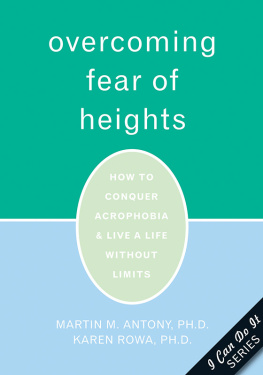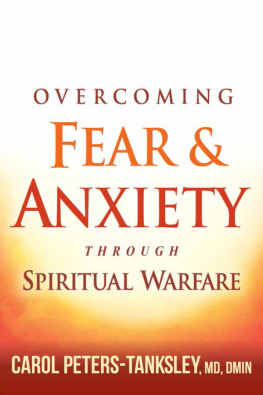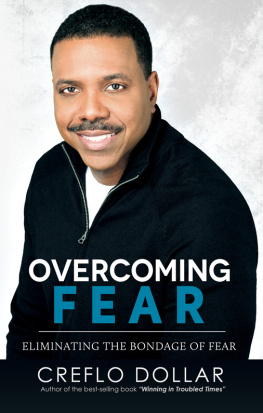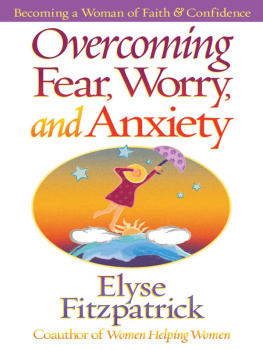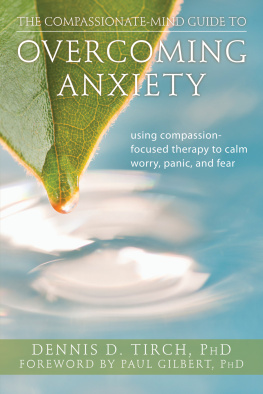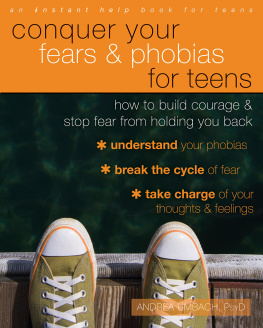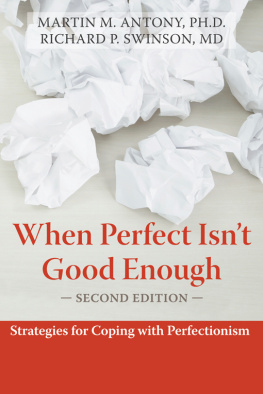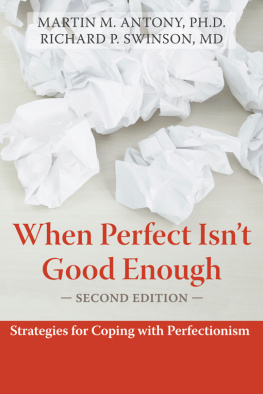Martin Antony - Overcoming Fear of Heights: How to Conquer Acrophobia and Live a Life Without Limits
Here you can read online Martin Antony - Overcoming Fear of Heights: How to Conquer Acrophobia and Live a Life Without Limits full text of the book (entire story) in english for free. Download pdf and epub, get meaning, cover and reviews about this ebook. year: 2007, publisher: New Harbinger Publications, genre: Religion. Description of the work, (preface) as well as reviews are available. Best literature library LitArk.com created for fans of good reading and offers a wide selection of genres:
Romance novel
Science fiction
Adventure
Detective
Science
History
Home and family
Prose
Art
Politics
Computer
Non-fiction
Religion
Business
Children
Humor
Choose a favorite category and find really read worthwhile books. Enjoy immersion in the world of imagination, feel the emotions of the characters or learn something new for yourself, make an fascinating discovery.
- Book:Overcoming Fear of Heights: How to Conquer Acrophobia and Live a Life Without Limits
- Author:
- Publisher:New Harbinger Publications
- Genre:
- Year:2007
- Rating:4 / 5
- Favourites:Add to favourites
- Your mark:
- 80
- 1
- 2
- 3
- 4
- 5
Overcoming Fear of Heights: How to Conquer Acrophobia and Live a Life Without Limits: summary, description and annotation
We offer to read an annotation, description, summary or preface (depends on what the author of the book "Overcoming Fear of Heights: How to Conquer Acrophobia and Live a Life Without Limits" wrote himself). If you haven't found the necessary information about the book — write in the comments, we will try to find it.
Anxiety experts Martin Antony and Karen Rowa bring you the third in New Harbingers I Can Do It series of books for specific phobias, and easy-to-use, exposure-based approach to overcoming fear of heights safely and effectively.
Martin Antony: author's other books
Who wrote Overcoming Fear of Heights: How to Conquer Acrophobia and Live a Life Without Limits? Find out the surname, the name of the author of the book and a list of all author's works by series.
Overcoming Fear of Heights: How to Conquer Acrophobia and Live a Life Without Limits — read online for free the complete book (whole text) full work
Below is the text of the book, divided by pages. System saving the place of the last page read, allows you to conveniently read the book "Overcoming Fear of Heights: How to Conquer Acrophobia and Live a Life Without Limits" online for free, without having to search again every time where you left off. Put a bookmark, and you can go to the page where you finished reading at any time.
Font size:
Interval:
Bookmark:
We would like to thank the staff at New Harbinger Publications for all of its hard work surrounding this book. Thanks especially to our editors, Catharine Sutker and Brady Kahn, to Amy Shoup for another great cover, to Dorothy Smyk (director of sales), Earlita Chenault (our publicist), and Michele Waters and Tracy Carlson for their work on the production of the book. Thanks also to Drs. Randi McCabe and Mark Watling, who, as coauthors of previous books in this series (on animal phobias and medical phobias, respectively), helped to shape the format of this book. Finally, a special thank you to our families for their support.
Martin M. Antony, Ph.D., is professor of psychology at Ryerson University in Toronto, ON, and director of research at the Anxiety Treatment and Research Centre at St. Josephs Healthcare in Hamilton, ON. He is also president-elect of the Canadian Psychological Association. He has published twenty-four books and more than 100 scientific papers and book chapters in the areas of cognitive behavioral therapy and anxiety disorders. He has received early career awards from the Society of Clinical Psychology (American Psychological Association), the Canadian Psychological Association, and the Anxiety Disorders Association of America, and is a fellow of the American and Canadian Psychological Associations. He is past president of the Anxiety Disorders Special Interest Group of the Association for Behavioral and Cognitive Therapies (ABCT) and has been program chair for the ABCT annual convention. He is actively involved in clinical research in the area of anxiety disorders, teaching, and education, and maintains a clinical practice. Visit him online at www.martinantony.com.
Karen Rowa, Ph.D., is a psychologist at the Anxiety Treatment and Research Centre at St. Josephs Healthcare and assistant professor in the Department of Psychiatry and Behavioural Neurosciences, McMaster University in Hamilton, ON. She received her Ph.D. in clinical psychology from the University of Waterloo and completed her predoctoral training at the Centre for Addiction and Mental Health in Toronto, ON. She completed a postdoctoral fellowship at the Anxiety Treatment and Research Centre before joining the faculty. Her research interests involve understanding ways to improve treatment outcomes for anxiety disorders. She has published numerous scientific papers and book chapters on the anxiety disorders and related topics. She is actively involved in clinical research, practice, teaching, and education.
Ross was terrified of heights for as long as he could remember. Ever since childhood, hed avoided roller coasters and Ferris wheels, skiing, standing on high balconies, and hiking in high places. He felt unsteady in these situations and feared that he might slip and fall. Although his fear affected the types of activities he could enjoy, it was never really a big problem until he got married and had children of his own. Rosss wife loved hiking, and he had promised her that they would go hiking together after they were married. His fear prevented him from following through on his promise. Also, his children loved amusement park rides and Ross was unable to ride with them, another source of embarrassment and distress for Ross. What finally led Ross to seek treatment was when his wifes parents moved into the penthouse of a high-rise condominium and Ross wasnt able to visit them.
Harpreet developed her fear of heights at the age of thirty-five. Her fear began suddenly when she was driving over the Claiborne Pell Newport Bridge during a vacation in Newport, Rhode Island. She was in the right-hand lane of the bridge and traffic was moving slowly. She began to feel panicky. Her heart was pounding and she felt very dizzy. She was sure she was going to lose control of the car and drive right off the bridge and into the water. It took all of her concentration to stay focused on getting to the other side. Returning from her vacation, she avoided the bridge entirely, taking another route. When she got home, she found herself avoiding local bridges that previously were never a problem for her. In fact, all elevated highways and roads had now become impossible for her to drive on. Many of the roads in her area had sections with steep drop-offs, so her new fear was making it difficult to go anywhere. She was fine in high places, as long as she wasnt driving (she had no trouble standing on a balcony), and she was fine driving, as long as the road wasnt elevated. It was specifically situations that involved a combination of height and driving that she found difficult. When Harpreet began treatment, she was spending an extra thirty minutes per day in the car, going out of her way to drive on roads that didnt include any elevated sections.
Vanessa avoided high places of all types, for fear that she would be drawn to the edge and jump off. She avoided balconies, fire escapes, bridges, rooftops, and the second floor of her local shopping mall. She avoided high places that were glassed in, even though she knew that she couldnt fall through the glass. Although she felt comfortable in regular elevators, glass elevators and escalators were a problem. She also avoided large staircases if they didnt have walls on both sides to block her view. Although she clearly didnt want to jump from high places (she was not feeling suicidal), when she was in a high place, she felt strangely pulled to the edge, and she didnt trust herself not to jump. It was easier to avoid heights altogether. Vanessas fear prevented her from visiting certain friends, and it also affected her job. She worked as a real estate agent and had to avoid showing certain homes (ones with open staircases, for example).
These three people all experience fear of high places, one of the most basic of all fears. From as early as six to ten months of age, human infants are able to perceive sudden drops in the surface of the ground and will avoid such drops. Experiments with a variety of animals, including chicks, lambs, goats, pigs, cats, and dogs, show that the ability to perceive a change in distance to the ground (in other words, a drop) tends to appear when an animal is able to stand on its own, and all of the animals studied develop a tendency to be cautious around heights, though the age at which the caution develops varies from species to species (Gibson and Walk 1960). In the case of chicks, avoidance of sudden drops tends to begin at an age of less than twenty-four hours. Clearly, we dont have to learn to fear heightscaution in high places seems to be something that we develop automatically. That is not to say that excessive or extreme fears cannot be learned. We will return to the issue of how fears of heights develop in chapter 2.
So, if it is normal to have a respect for heights, why might it be important to consider overcoming such a fear? The goal of this book is not for you to end up with no fear of high places. Some degree of apprehension is useful for preventing you from taking risks that are potentially dangerous. A fear of heights is only a problem if it bothers you, or if it interferes with your ability to do the things that you want to do. For Ross, Harpreet, and Vanessa, fear of heights was clearly a problem.
The term phobia has a very specific definition, according to the fourth edition of the Diagnostic and Statistical Manual of Mental Disorders (American Psychiatric Association 2000). To be considered a phobia, a fear of heights must have a number of features, of which two are particularly important. First, the fear must be excessive or unrealistic. In other words, your level of fear must be out of proportion to a situations actual danger. Second, the fear must cause significant distress or impairment. In other words, you must find the fear to be bothersome, or the fear must interfere with aspects of your functioning at work, in relationships, or in other important domains of living. So, a fear that rarely comes up, doesnt bother you, and doesnt cause significant problems in your life would not be considered a phobia.
Font size:
Interval:
Bookmark:
Similar books «Overcoming Fear of Heights: How to Conquer Acrophobia and Live a Life Without Limits»
Look at similar books to Overcoming Fear of Heights: How to Conquer Acrophobia and Live a Life Without Limits. We have selected literature similar in name and meaning in the hope of providing readers with more options to find new, interesting, not yet read works.
Discussion, reviews of the book Overcoming Fear of Heights: How to Conquer Acrophobia and Live a Life Without Limits and just readers' own opinions. Leave your comments, write what you think about the work, its meaning or the main characters. Specify what exactly you liked and what you didn't like, and why you think so.

